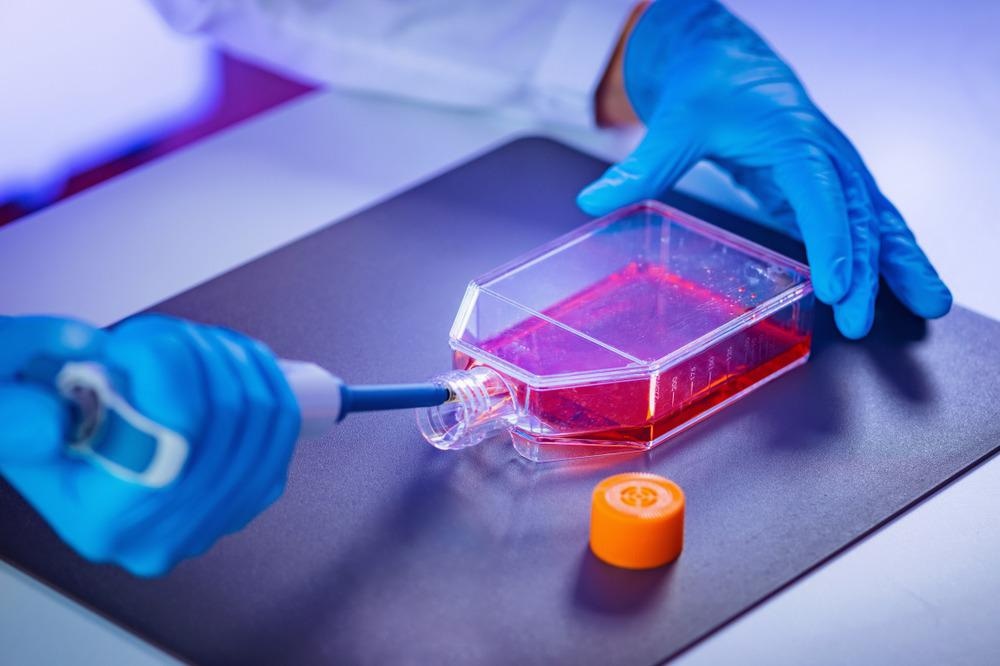 By Surbhi JainReviewed by Susha Cheriyedath, M.Sc.Apr 1 2022
By Surbhi JainReviewed by Susha Cheriyedath, M.Sc.Apr 1 2022In a review recently published in the journal Bioprinting, researchers discussed four-dimensional (4D) bioprinting and its potential for advanced tissue engineering applications.

Study: A review on four-dimensional bioprinting in pursuit of advanced tissue engineering applications. Image Credit: Microgen/Shutterstock.com
Background
By creating incredibly accurate and intricate products, additive manufacturing (AM), also known as three-dimensional printing (3DP), has transformed the globe. The unique 3DP technique has captivated the biomedical sector in the last decade, and it has been widely employed in the disciplines of tissue engineering (TE), regenerative medicine, and pharmaceuticals.
Tissue pictures are used to create computer-aided design (CAD) files that allow the manufacturing of 3D-printed (3DPed) patient-specific tissue structures using digital imaging methods such as X-ray computed tomography (CT) or magnetic resonance imaging (MRI). Engineered tissues created with 3DBP technology, on the other hand, are static and inflexible, unlike organic tissues, and don't usually change shape over time, which limits their usage in a dynamic environment.
Due to insufficient tissue development or maturation, 3DPed tissue constructs are limited in their practical uses. With the advancement of stimuli-responsive materials (SRMs), particularly shape memory polymers (SMPs), a new biomedical technology known as "four-dimensional (4D) bioprinting" has recently gained traction.
Currently, 4DBP technology has shown tremendous promise in the biomedical field, particularly in TE applications. The majority of reviews focus on the 3DP of polymeric materials; nevertheless, 4DBP technology for tissue constructs is still in its early stages and requires significant attention in order to promote practical applications.
About the Study
In this study, the authors presented a state-of-the-art review encompassing various types of SRMs and bioprinting methods as per the current market trends for 4DBP technology. Furthermore, this review included many bioactive materials used in soft and hard tissue engineering (TE) applications. Current issues in the TE area were also highlighted, which could pave the way for prospective future developments.
The team discussed the current challenges and potential developments of 4DBP technology for soft and hard tissue constructs. The crosslinking technique, printing speed, cell density, material viscosity, cell survival, resolution, printer cost, bio-ink materials, and major TE applications of typical bioprinting technologies were compared.
The authors summarized the many stimuli employed for the 4DP of shape memory materials (SMMs). To construct dynamic 3DPed scaffolds for bone, cartilage, and heart, as well as to generate biomedical devices, the use of cell traction forces (CTFs) or diverse environmental changes was demonstrated. The stimuli that were used in the tissue construction process using 4DP technology were also demonstrated. The preparation of a 3D microstructure using the CTF approach was illustrated, which could be used in medication delivery systems. In addition, the shape morphing ability (swelling and folding) of 4Dconceptualized Gel film was shown.
Observations
4DBP technology was observed to be an extension of 3DBP technology that integrated time as its fourth dimension. Recent advances in SRMs, particularly SMPs and shape memory hydrogels (SMHs) had made 4DBP technology a highly acceptable approach for clinical use. Many studies demonstrated that 4DBP technology could be used for soft and hard tissue regeneration. The shape change ability of the bioactive materials displayed biomimicking features during the post-printing phase, which facilitated tissue remodeling throughout the maturation period.
More from AZoM: What is the Universal Chiplet Interconnect Express (UCIe) Standard?
Several studies determined that incorporating traditional industrial engineering principles into biofabrication, such as lean manufacturing and six sigma, could lower costs and improve efficiency. The structural features and composition of scaffolds were observed to be critical factors in determining tissue load-bearing capacity.
It was demonstrated in some studies that for cellular differentiation, proliferation, and migration to be stimulated, the contact between 4DPed scaffolds and cells must be appropriate. Encapsulation and releasing of biomolecules for the appropriate functioning of biomimetic scaffolds in bone tissue engineering (BTE) could be possible with further breakthroughs in nanotechnology and nanoscience.
The use of live cells was the most important prerequisite for 4DBP technology, and 4DPed materials must be biocompatible and non-cytotoxic. Furthermore, it was observed that rheological properties should be appropriate for improved printability and high cell survival. Non-toxic crosslinkers were found to be another prerequisite for proper bio-printed architectural stabilization.
Conclusions
In conclusion, this study elucidated that the bioactive materials should be tuned for hybrid architecture preparation. It was observed that 4DBP has a natural ability to build deformable designs in response to external stimuli, and it could be potentially used to make vascular scaffolds. Structural design and material selection are two significant parameters to consider while developing vascular scaffolds. 4DBP technologies were found to be the most appropriate strategies for vascularization development.
The authors emphasized that further research into the biomechanical performance and functions of native tissues, the creation of multi-functional hierarchical architectures for mimicking native extracellular matrix (ECM) characteristics, and the development of cost-effective and rapid prototyping 4DBP technologies for biomedical settings are all necessary for future advancements in the TE field. They also believe that the 4DBP technology is expected to fundamentally transform the biomedical business in the near future.
Disclaimer: The views expressed here are those of the author expressed in their private capacity and do not necessarily represent the views of AZoM.com Limited T/A AZoNetwork the owner and operator of this website. This disclaimer forms part of the Terms and conditions of use of this website.
Source:
Arif, Z. U., Khalid, M. Y., Ahmed, W., et al. A review on four-dimensional bioprinting in pursuit of advanced tissue engineering applications. Bioprinting e00203 (2022). https://www.sciencedirect.com/science/article/pii/S2405886622000136.